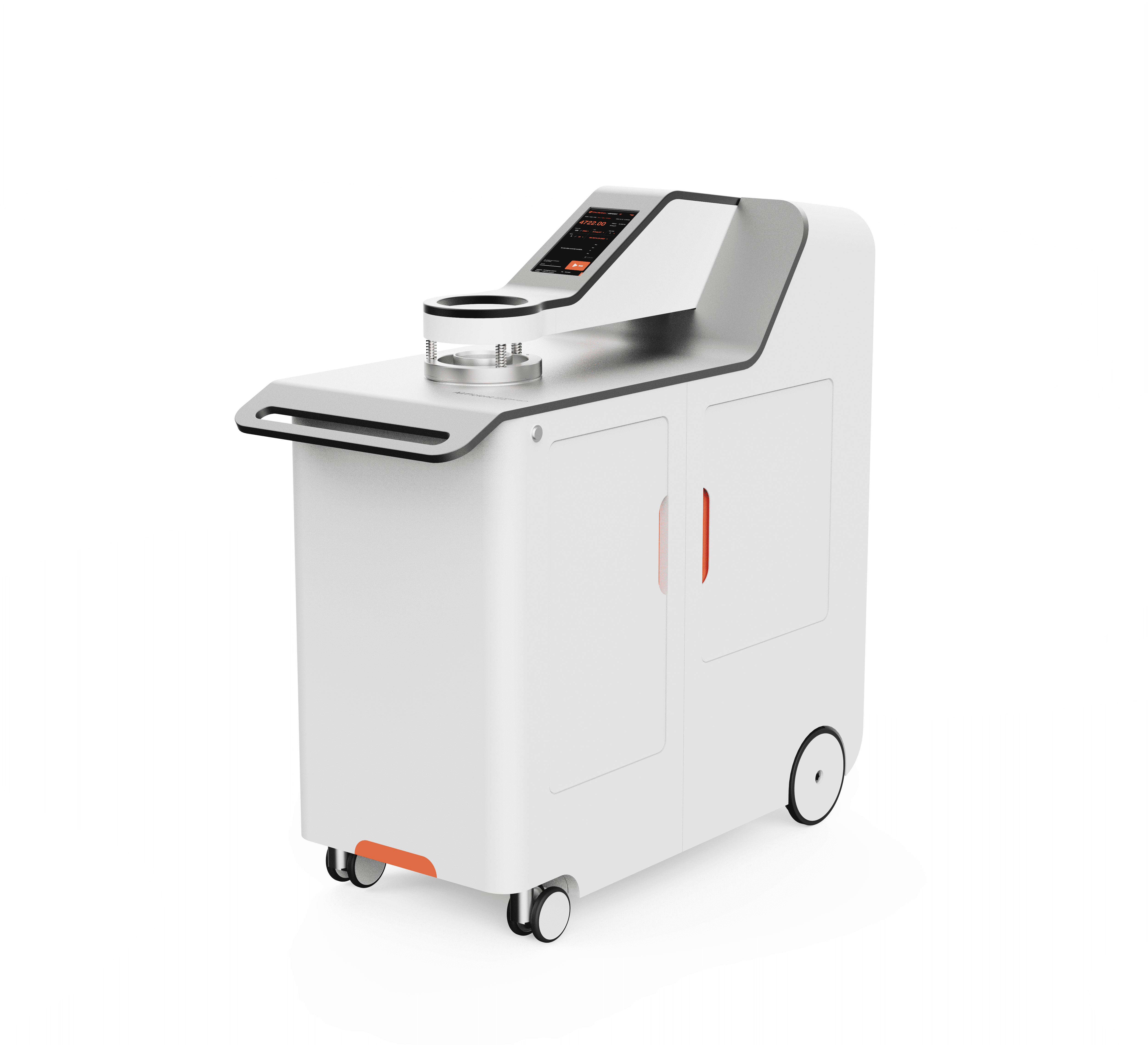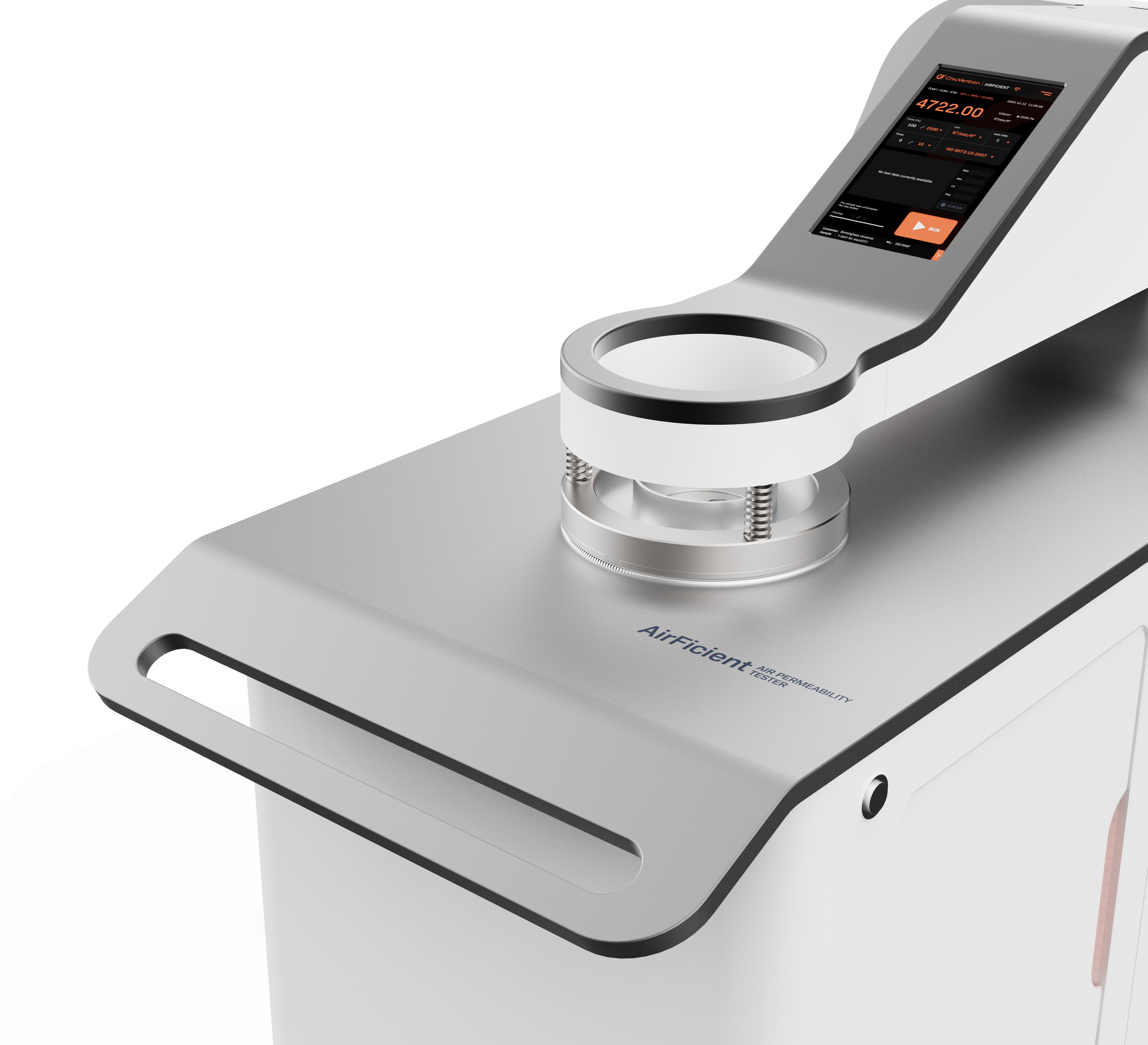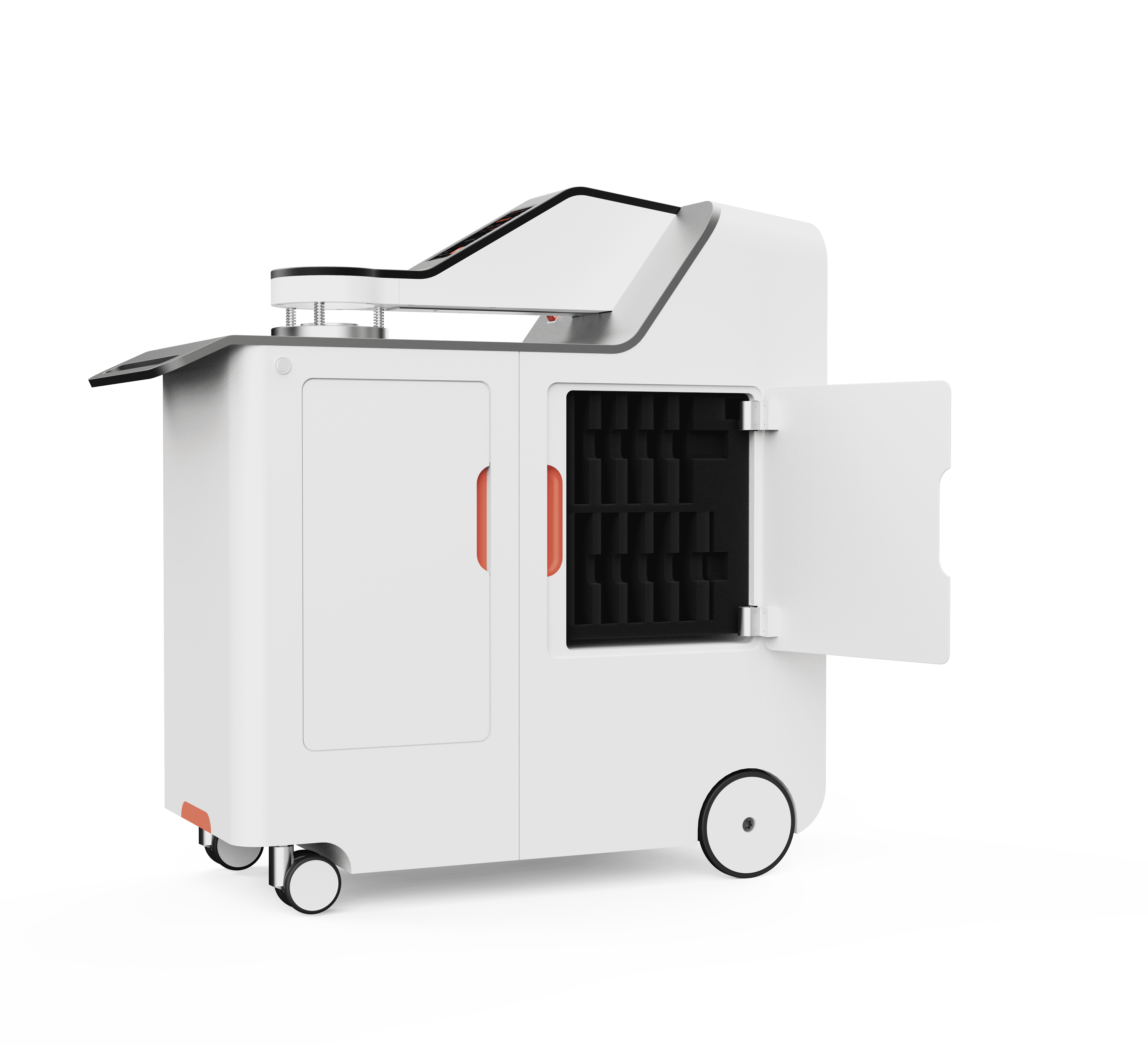AirFicient Air Permeability Tester | A smart instrument developed by the sister company ChiuVention.
The AirFicient Air Permeability Tester allows you to quickly get reliable air permeability test results, and it is a smart instrument so you can set parameters, monitor the test status, etc., from your smartphone, which greatly improves work efficiency. This permeability apparatus is suitable for a variety of textiles including technical fabrics, non-woven fabrics, and other breathable products such as sponges paper, and other materials for air permeability testing. Applicable to GB/T5453, ISO 9237, ISO 9073:15, JIS L1096 Item 8.26 Method C, BS 3424-16, BS 6F 100 3.1, NWSP 070.1.RO(15), GB/T 24218.15, etc.
The principle is that the air passes vertically through the fabric, forming a certain pressure difference between the front and back sides of the fabric, measuring the amount of air going through the fabric under a certain pressure difference, thus obtaining the air permeability value.
Description
Tests are easy and fast.
The AirFicient Air Permeability Tester is easy to operate, you can select the test standards and measurement units from the operation screen. The instrument can automatically recognize the different ranges of the test fixture head. You can start the permeability test and get the result directly.
More reliable test results
Innovative test model, the range conversion components are maintenance-free, no loss, bringing high repeatability and reliability to air permeability test results. High-quality core components, such as pressure sensors from famous brands, further ensure the accuracy of the air permeability test results.
Smart instrument
The AirFicient Air Permeability Tester can be connected through Wi-Fi with the SmarTexLab App installed in the smartphones, you can set parameters, monitor the test status, receive equipment warning reminders, etc., and share air permeability test results with the quality control department or brand buyers.
Application
AirFicient Air Permeability Tester or air permeability testing machine widely used to test the resistance of fabrics (woven, knitted, and non-woven textile materials, medical masks) to the passage of air (airflow), the test textile is firmly clamped by a specified rig of selected test head/area to resist the constant air pressure settled before the air permeability test.
The specimen is loaded to the test area of the instrument easily using an automatic holder. Press down the holder to start the test. The air permeability testing machine is equipped with a vacuum pump to draw air through an automatic interchangeable test head with a circular opening. The pre-selected test pressure is automatically maintained, and after a few seconds the air permeability of the test specimen is digitally displayed in the pre-selected unit of measure on the touch panel, or the next test nozzle required to be replaced will be displayed. After the air permeability test, the holder is released and the vacuum pump will be shut off.
The Specifications of AirFicient Air Permeability Tester
Measurement units: mm/s, m/s, l/m²/s, ft³/min/ft², cfm, cm³/s/cm², l/s/cm², l/m²/min
1/dm²/min ,l/min, m³/min, dm³/s
m³/s/m², m³/min/m², m³/h/m², ft³/s/ft²
| Test Mode | Automatic |
| Test head | 20 cm² (standard) |
| Test pressure | 10 ~ 2,500 Pa |
| Air velocity | 0.6 ~ 10,000 mm/s (20 cm²) |
| Measurable sample thickness range | 0 ~ 10 mm (other thicknesses and fixtures can be customized) |
| Testing Accuracy | < +/-2% |
| Optional test heads | 5 cm², 25 cm², 38 cm², 50 cm², 100 cm² |
Weight of Air Permeability Testing Machine
125kg
Power of Air Permeability Testing Machine
220V/110V 50/60Hz
Dimension of Air Permeability Testing Machine
970*400*970 mm (D*W*H)
Standards of Air Permeability Testing Machine
GB/T 5453 ISO 9237
ISO 9073:15 JIS L1096 Item8.26 Method C
BS 3424-16 BS 6F 100 3.13
NWSP 070.1.RO(15) GB/T 24218.15
Optional Standard of Air Permeability Testing Machine
ASTM D737
TESTEX provides good quality air permeability testers for textiles, for more information on air permeability test apparatus, or want to know the air permeability tester price or air permeability test standards, welcome to contact us now! You can also directly have a nice chat with us via the What’s App.
You must be logged in to post a review.
Frazier air permeability test method (ASTM D737 testing)of textiles
1.Air permeability definition
What is the permeability of air? The air permeability is the volume of air passing a fabric under pressure. There are two types of air permeability tester for textiles, Frazier air permeability tester and Shirley air permeability tester. In ASTM D737 test method, we take Frazier differential pressure air permeability tester as an example.
2.Test Objectives:
To determine the air permeability of textile fabrics by calculating the air permeability value.
3.Test Materials:
Woven, knitted and non-woven textile materials. eg. cotton.
4.Air Permeability Test Procedure:
4.1 The specimens must be adjusted to the standard atmosphere with 21 +/- 1°C (70 +/- 2°F) and 65 +/- 2 % relative humidity unless there is otherwise specification of contract order.
4.2 Process the specimens carefully and prevent it from changing its' natural state.
4.3 Place each specimen on the test head of the air permeability tester and control the test as the operation manual.
4.4 At the conditioned water pressure, making tests according to the operation manual. In the absence of an operation manual, use a water pressure 125 Pa (12.7mm or 0.5 in. of water).
4.5 Read and record the test results. The air permeability units should be noted. Record the test results respectively in SI units as cm^3/s/cm^2 and in inch-pound units as ft^3/min/ft^2 rounded to three significant digits.
4.6 Take out the tested specimen and continue to test the next specimen until the ten specimens have been tested in accordance with the flow of 4.3-4.5.
4.7 In order to make sure a high accuracy, the number of tests is at least four.
5.Air Permeability Calculation
Calculate air permeability of every specimen by reading directly from the tester in SI units as cm^3/s/cm^2 and in inch-pound units as ft^3/min/ft^2, rounded to three significant digits. Please follow the instructions which the manufacturer provides when calculating air permeability.
Note-If air permeability test results are 600m (2000 ft) above the sea level, it needs correction factors.
6.Report
The data which is needed to report is as follows.
6.1 Report whether the air permeability is in accordance with the Test Method D737.
6.2 Report the standard deviation and the variation factor while calculating.
6.3 The difference in pressure of fabric surfaces.
6.4 Report the model and the manufacturer of the air permeability test equipment.
What important points should be paid attention to when measuring air permeability?
1 Calibration board must be used before each test (all boards should be checked). Mainly air circuit, liquid circuit, air leakage, liquid leakage, position moving will cause an error to the air permeability tester.
2 The sample should be fixed at the intake hole naturally and smoothly. Usually, it does not need to distinguish between positive and negative, but if the positive and negative differences of structures (such as umbrella cloth, filter cloth, pile fabric) are big, air flow direction should be decided according to the actual use.
3 The caliber is selected in order of large to small to avoid the excess of liquid in the pressure gauge. The final selected caliber should be under the indication range of the 15%~85%.
4 Moderate pressure regulation makes the pressure gauge slowly change from low value to constant pressure value. If the liquid level has exceeded the constant pressure value, it must be adjusted back to a lower pressure level and re-adjusted. The pressure has to be stable for a period of time and then can be read.
5 Make sure that the end of the pressure gauge passes through the atmosphere without clogging. Some instruments have covers and should be taken down when measuring.
6 There is a nonlinear relationship between the air permeability and the differential pressure of two sides of the fabric (constant pressure value). The air permeability under differential pressure can be compared according to the following formula:
Q_M=Q_N(∆P_M/∆P_N)^b
The air permeability under the same differential pressure is converted, Q_M and Q_N of which are the air permeability under the constant pressure value of ∆P_M and ∆P_N, and the B is determined by the fabric category and ∆P_N.
7 Different countries have different air permeability unit of measurement. Therefore, please pay more attention to the air permeability units conversion. If you need to convert 1/ dm^2/min to m^3/ m^2/ minor convert l/ dm^2/ min to l/ m^2/ s, here is the air permeability conversion chart as follows for your reference.
Please contact us if you want to know the air permeability tester price or download a free ASTM D737 test for permeability PDF.
[contact-form-7 id="16355" title="Inquiry"]
A: The fabric air permeability is to measure the volumn of air flow through it. The ease or passage of air plays an important role in end uses of many fabrics, such as industrial filters, tents, sailcloths, parachutes, raincoat materials, shirtings, downproof fabrics and airbags.
Air permeability refers to the volume of air per ml which passes the fabric at a speed of 1s or 10s/mm^2 in a pressure difference of 10mm water head.
Q: How to test the air permeability of fabric?
A: In British standard test, the volume of airflow through a specified area is measured at a certain pressure across the fabric with 10mm water head. Test sample is clamped over the inlet of device with rubber gaskets, and air is sucked through it by pumps, which is shown in Fig.A. The air valve is adjusted to exert pressure on air going through fabric of 10mm water head, then a flow meter is used to measure airflow.
Fig(A) : The air permeability test (click here for more)
Q: What is the unit of air permeability of fabric?
A: The formula is as follows:
K (gas) = Q / (ΔP × A)
Where: K( gas) - air permeability, m ^ 3 / m ^ 2 · KPa · h;
Q - gas flow, m ^ 3 / h;
ΔP - gas through the porous material produced by the pressure drop, KPa;
A - area of the sample's test area, m ^ 2



Reviews
There are no reviews yet.